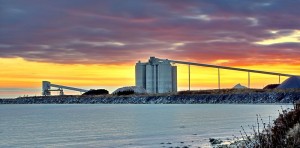Economy
Characterized by large and well developed agricultural, mining, manufacturing, and service sectors, Brazil?s economy outweighs that of all other South American countries and Brazil is expanding its presence in world markets, where it is currently the 8th biggest economy (by GDP – purchasing power parity) in the world.
It has weathered many storms, such as the military dictatorship 1964–1985, hyperinflation in the 1990s and in 2009 came out of a very short lived recession (just two quarters). The Gross Domestic Product (GDP) in Brazil expanded 0.8 percent in the second quarter of 2011 over the previous quarter. Historically, from 1996 until 2011, Brazil’s average quarterly GDP Growth was 0.80 percent reaching an historical high of 4.50 percent in September of 1996 and a record low of -4.20 percent in December of 2008. Brazil is one of the fastest growing emerging economies in the world. With large and growing agricultural, mining, manufacturing and service sectors, Brazil economy ranks highest among all the South American countries and it has also acquired a strong position in global economy.
Recent developments
Brazil’s economy expanded at a softer pace in the second quarter as a strong currency fueled a flood of cheap imports and industrial activity turned sluggish.
Gross domestic product grew 3.1% in the second quarter from the same period a year ago, the Brazilian Geography and Statistics Institute, or IBGE, said on September 2, 2011. GDP expanded 0.8% compared with the first quarter of this year.
The second-quarter figures show that Latin America’s largest economy is reacting as expected to a series of interest-rate increases and other measures implemented by the government in late 2010 and early 2011, designed to contain inflation by reining in access to credit. But the softer pace to growth has the government and economists lowering expectations for GDP expansion in 2011.
Despite the downward trend in Brazil’s economy over recent quarters, the IBGE data showed hidden areas of strength. Economic-activity levels in nearly all of the sectors measured by the GDP survey have climbed above the robust levels reached in the second quarter of 2008, right before the financial crisis struck, said Rebeca Palis, an IBGE economist. The lone holdout is Brazil’s industrial sector, which is operating at historically elevated levels but still a smidge below the pre-crisis peak, she added.
The country’s massive industrial segment has struggled with a surge in cheap imports, which have flooded into Brazil because of the strength of the real currency. The real has gained more than 10% against the U.S. dollar over the past 12 months. Imports were up 14.6% year-on-year in the second quarter versus 6.1% growth in exports, the IBGE said.
More important, the slower growth pace does not support the surprising interest-rate cut made earlier this week, BES Investimentos said. The central bank cut its benchmark Selic rate a half-percentage point to 12.0%, citing the need to stimulate the economy ahead of an expected global recession.
Currently , large investments being made by local/international companies and government, such as an estimated $ 112 billion worth of investment by Petrobras in the Oil & Gas sector by 2012, $ 300 billion investment by the government to modernize the road networks, power plants and ports and the World Cup in 2014 with the Olympics following in 2016. These and many more investments and pro?active policy management by the government provides a relatively stable, growing platform for foreign investors for the coming years.
The Currency of Brazil
The Brazilian currency is the Real. The real (plural reais) was implemented on 1 July 1994, during the presidency of Itamar Franco, when Fernando Henrique Cardoso was the Minister of Finances, as part of a broader plan to stabilize the Brazilian economy, known as Plano Real, substituting the short-lived cruzeiro real. It initially appreciated against the dollar, however then started a slow deprecation until 2002 where it hit an all time low of almost R$ 4 per $1. It has since appreciated again and has been trading at R$ 1.50 and R$ 2.50 per $1 for the last couple of years.
National Statistical Data


